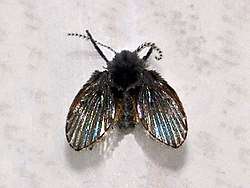Clogmia albipunctata
| Clogmia albipunctata | |
|---|---|
 | |
| Clogmia albipunctata | |
| Scientific classification | |
| Kingdom: | Animalia |
| Phylum: | Arthropoda |
| Class: | Insecta |
| Order: | Diptera |
| Suborder: | Nematocera |
| Family: | Psychodidae |
| Genus: | Clogmia |
| Species: | C. albipunctata |
| Binomial name | |
| Clogmia albipunctata (Williston, 1893) | |
Clogmia albipunctata is a species of drain fly member of the family Psychodidae.[1]
Distribution
This very common species is present in part of Europe, in the Afrotropical realm, in the Nearctic realm, in the Neotropical realm, in North Africa and in the Indomalayan realm.[2]
Description
Clogmia albipunctata can reach a length of 3–5 millimetres (0.12–0.20 in). Both the body and the wings are covered with thick gray-brown hair. Wings are pointed, with some white spots (hence the Latin species name). Despite being a diptera, has a similar appearance to that of a small moth. Antennae show dense setae, each segment with separate whorls.[3]
Biology
Adults do not feed. They spend most of their life lying on the walls. They move rarely, and with weak flight. The larvae live in aquatic environments, feeding on organic decaying matter. They often infest the drains of the bathrooms and for this reason in the United States they are also known as bath flies.
Although they are considered harmless, some cases of myiasis caused by the larvae of this insect are reported in the literature, at the nasal, intestinal and urinary levels.[4][5][6]
References
| Wikispecies has information related to Clogmia albipunctata |
| Wikimedia Commons has media related to Clogmia albipunctata. |
- ↑ BioLib
- ↑ Fauna europaea
- ↑ The Diptera Site
- ↑ Nevill EM, Basson PA, Schoonraad JH, Swanepoel K, A case of nasal myiasis caused by the larvae of Telmatoscopus albipunctatus (Williston) 1893 (Diptera: Psychodidae), in S Afr Med J. 1969; 43(17): 512-4.
- ↑ Tu WC, Chen HC, Chen KM, Tang LC, Lai SC, Intestinal myiasis caused by larvae of Telmatoscopus albipunctatus in a Taiwanese man, in J Clin Gastroenterol 2007; 41(4): 400-2.
- ↑ Kamimura K., Arakawa R, A case report on urinary myiasis due to the moth fly Telmatoscopus albipunctatus, in Medical entomology and zoology 1986; 37(2): 161-162